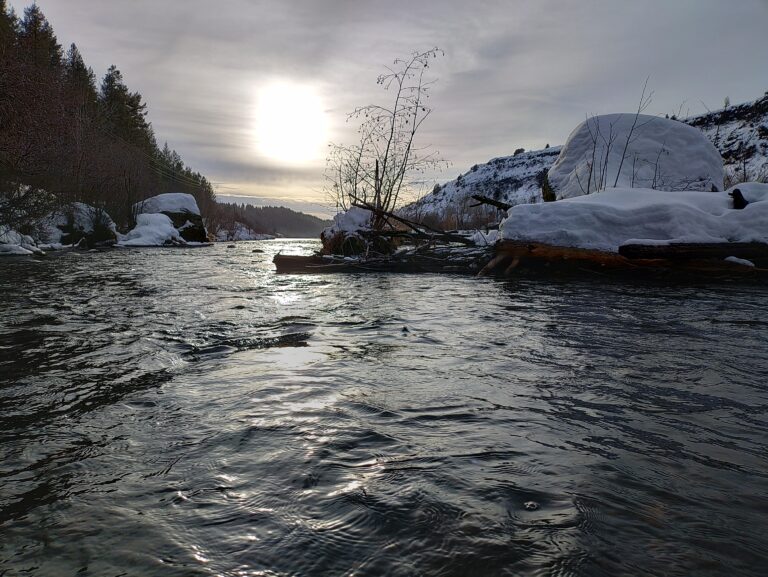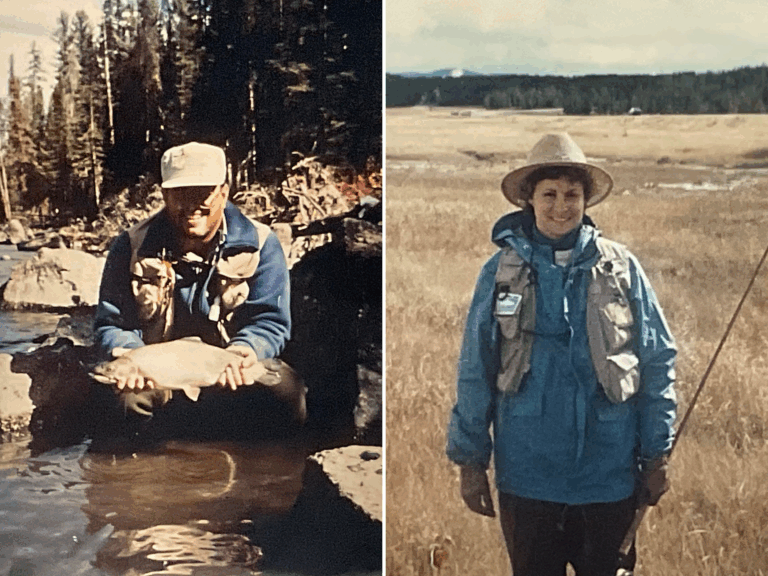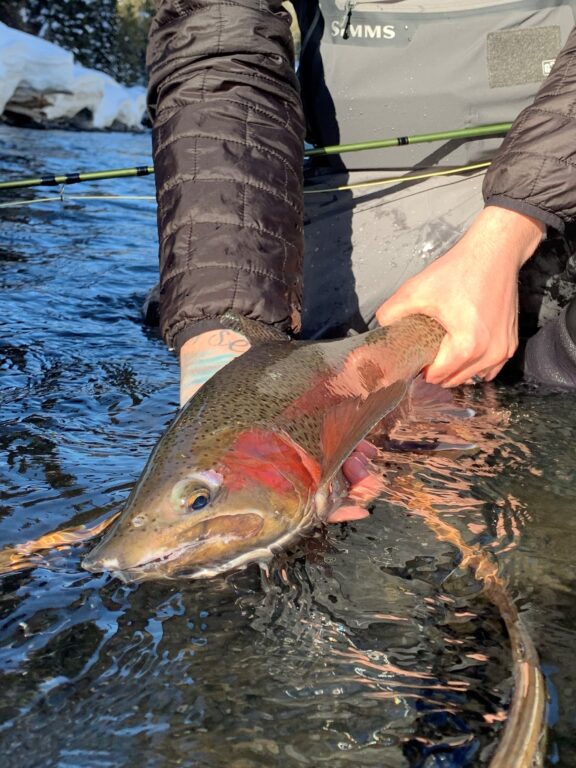As summer transitions to fall, we’re reflecting back on where we were as of the start of the year.
Originally published January 23, 2024.
It may have been said many times before, but it’s worth repeating – the Henry’s Fork is one-of-a-kind. The phrase “one-of-a-kind” gets used a lot, but the Henry’s Fork truly meets the definition. It’s a place unlike any other. If you were lucky enough to travel the world, you would be hard-pressed to find another fishery of this quality, with this scenery, with this community of people, that fishes year-round, and has nearly 50 access sites from top to bottom. Why do we come back year-after-year? Why does the Henry’s Fork Foundation do what we do? Because the Henry’s Fork is one-of-a-kind, and something that special is worth protecting.
How can we protect what we love?
In the face of changing climate, drought, warmer spring time temperatures, and changes in water availability, our fishing experience is changing, both here and across the West. When we look back at the Henry’s Fork history, the river had some golden years from the 1970s-1980s, with record-setting water supply not seen before and so far, not seen since. We may be at Mother Nature’s mercy when it comes to how much snow or rain falls, and unless she blesses us with another couple decades of above-average water supply, we may not be able to recreate the past. However, that doesn’t mean we don’t still have an absolute gem of a river – worth protecting and ensuring it’s as healthy as it can possibly be. That’s what we do. That’s what we strive for each and every day.
Aquatic Insects
Concerns over declines in insect populations in various locations across the globe continue, and rightfully so. Although the Henry’s Fork still boasts astonishing aquatic insect numbers and noteworthy hatches along quite a bit of its 100+ river miles, it does not minimize the severity of the issue, nor its potential to reach the Henry’s Fork in the future. It also does not minimize the changes anglers have observed in timing, location, and size of insects on the Ranch.
Data collected in 2023 showed substantial improvement in almost all measures of the invertebrate community at Last Chance and Osborne Bridge relative to 2021 and 2022. Percent mayflies, stoneflies and caddisflies at Last Chance was over 70%, the highest we have seen there since data collection began in 2015. These improvements come in a year when anglers reported less than ideal hatches, illustrating that strong insect population metrics do not necessarily translate to good hatches, or hatches occurring at expected times of the day.
The section of river from Island Park Dam to Riverside, including the Harriman State Park (“Ranch”) reach, experiences much more year-to-year variability in insect populations than the rest of the river. This variability is tied to Island Park Reservoir flows and management, which gratefully, we’ve had a good deal of success impacting in recent years. The Henry’s Fork Aquatic Insect Monitoring program (AIM for Healthy Rivers) is heading into its 10th year, with annual samples and analysis conducted throughout the watershed, including at Last Chance and Osborne Bridge.
This analysis, coupled with the extensive water temperature monitoring conducted in the Ranch last summer, will allow us to continue to dig into why anglers are observing changes in their favorite hatches, just as scientists across the globe continue to try to determine what is causing these insect declines. We may be fortunate here on the Henry’s Fork compared to most, but that doesn’t mean we can’t be on the leading edge of understanding, and addressing, these issues.
What’s next?
We will continue our annual monitoring, which is producing one of the most comprehensive and scientifically rigorous long-term invertebrate datasets on any trout stream anywhere in the western U.S. Over the past year, we have worked with aquatic entomologist Brett Marshall from River Continuum Concepts to develop a statistically rigorous analysis to identify the most important environmental predictors of macroinvertebrate community structure in the Island Park to Pinehaven reach. Nothing of this nature and magnitude has ever been done on the Henry’s Fork, and it is likely that nothing like this has been done on any trout stream in the West. For a full, detailed explanation of how this works, view Dr. Van Kirk’s report (pg 35).
The goal of this analysis is to help explain why and how the current insect community is different than it was four decades ago, and what can be done to minimize the future effects of increasing temperatures and decreasing water supply. Finally, we are currently writing a plan—and a $1 million WaterSMART grant application—called DIRTT: Developing Infrastructure to Reduce Turbidity and Temperature, to investigate and ultimately implement large-scale projects to help offset the negative effects of increased temperatures and decreased water supply on aquatic ecosystem function between Island Park Dam and Pinehaven.
Given that our collaborative water conservation actions have already reduced reservoir draft by ~26,000 ac-ft/year, thereby reducing outflow temperature, turbidity, and sediment load, we believe that infrastructure changes to the reservoir and dam, as well as site-specific management actions such as aquifer recharge in Island Park, can provide even more resiliency to climate variability in the future.
Full technical report on Henry’s Fork aquatic insect populations (pg 30-35).
Sediment and Turbidity from Island Park Reservoir
Although turbidity remained low throughout the summer of 2023, and water quality metrics like water temperatures were among the best they’ve been in years, looking into factors that affect water quality and strategies to improve it, remains of critical importance. We’ve learned a lot about Island Park Reservoir in recent years. HFF’s Aquatic Ecology Program Manager, Dr. Jack McLaren studied multiple aspects of the reservoir for both his Masters and PhD research. Data indicates that sediment exiting Island Park Reservoir into the Henry’s Fork are not from tributaries. Sediment—which is made up of both inorganic bottom sediments as well as dead algae—is instead being moved from the shallow west end through density currents caused by cold-front weather events. The west end of the reservoir sits in a valley made of sediment, eroded off the Centennial Mountains over geologic time and then flooded upon the creation of the reservoir.
HFF’s work reduced sediment exiting the reservoir into the river downstream by 150 tons in 2023. HFF’s application for a $1-million grant to launch a the new DIRTT Program will support this work. The DIRTT program will assess potential projects to reduce fishing-season sediment export from the reservoir into the river downstream, reduce water temperatures, and benefit the fishery in the face of changing conditions.
What else can we do?
Water Temperatures
For anglers across the world, a sunrise walk in Harriman State Park is a spiritual experience. However, anglers have become concerned about water temperatures there, and the potential effects on the river’s aquatic life. That’s why HFF asked anglers to help select 17 locations in the Ranch to monitor water temperature throughout the summer of 2023. Volunteers helped hike to key Ranch sites and install monitors. The data is now available online and HFF is researching options to bolster the cool water refuges throughout the Ranch reach.
A few of the key data highlights include:
- Water temperatures on the Ranch are highly variable and respond to weather, Island Park Reservoir drawdown, outflow volume, and the influence of cold groundwater input (which begins downstream of Bonefish Flats).
- Cool groundwater inputs keep water temperatures stable between Millionaire’s and Piney Point (which is remarkable for a wide slow section of river).
- Once downstream of Osborne Springs, of course, river left is much cooler than river right. River right stays more or less consistent in temperature from Osborne Bridge all the way to Pinehaven (again, remarkable).
- Surface water inputs, in contrast, are no cooler than what’s in the Henry’s Fork already.
HFF’s DIRTT Program also aims to help contribute additional groundwater and reduce overall water temperatures in the Ranch.
Trout Populations
We can help the insect populations, address water temperatures, and clear out sediment, but none of it will make a difference without trout rising to those bugs, in that cool, clear water. Research done in the early days of the Foundation established that winter flow from Island Park Reservoir is the number one factor affecting trout survival from Island Park Dam to Pinehaven. We also know that trout populations below Mesa Falls are much more consistent year-to-year. But, how can we boost winter flows to help the trout populations in some of our most storied reaches?
Two programs are achieving results envied across the West. Precision Water Management and Farms & Fish may just be the future of fisheries conservation. Working with farmers and zwater managers to more precisely manage water, boost soil health, and conserve water, has made sure there is an additional 10,000 Olympic swimming pools worth of water (~25,000 acre-feet) in Island Park Reservoir at the start of the winter for better winter flows. This work has also made spring freshets possible, clearing out fine sediment and making more ideal habitat for insects. Plus, there is the federally funded, multi-million-dollar Conant Creek Canal partnership improving trout habitat, reducing sediment runoff, and contributing to winter flows. And on top of all of that, landmark research by HFF’s Dr. Christina Morrisett, is helping the water world consider how traditional flood irrigation may actually help increase groundwater return flows for trout habitat, and ponder the age-old question – is newer really better?
Aquatic Vegetation and Algae in the Ranch
Anglers are noticing that the more filamentous algae there is in the river, the harder it is to wade. Plus, fish and flies both tend to get tangled more readily in algae than in the regular macrophytes–the typical rooted aquatic vegetation trout use as habitat in the Harriman State Park reach. Filamentous algae were first recorded in the Henry’s Fork by scientists studying macrophytes in 1991. It was abundant then, less abundant in 1992 and 1993, and very abundant in 1994. It was also very abundant in 2009, the next time the systematic macrophyte surveys were repeated. HFF collected additional macrophyte data during PhD research conducted in 2013-2014, and 2018-2021.
The most recent research included a study of how submerged macrophytes change river geomorphology and how fish habitat relates to submerged macrophytes. Submerged macrophytes create their own unique habitats. They form scour holes in the “slots” between macrophyte clumps. The trout usually avoid macrophytes when selecting habitat, but once macrophyte cover hits a high enough level (>95% coverage), then the fish really start to key in on macrophyte-forced habitats.
Trout don’t really seem to use submerged macrophytes as explicit overhead cover or as a current break. Instead they want those “conveyor belts” where faster water forced between macrophytes scours out a little feeding line with faster current delivering insects to the fish. This is something experienced Ranch anglers likely already know, but is interesting as it shows just how flexible trout can be in responding to habitat changes.
There’s a long-term balance between too many plants and too few plants. Currently, our best available science suggests an oscillation between years of high aquatic plant growth and years of low aquatic plant growth may produce both high productivity and good aquatic insect habitat. We’re committed to continuing 30 years of research on aquatic vegetation. We’ll continue to use our research to design and initiate water-saving and flow management projects, such as the spring freshet, to produce positive outcomes for aquatic life on the Harriman Ranch.
We know there are other concerns like invasive species (Quagga Mussels), river use, and etiquette, for example. We will continue to work with partners like the Idaho State Dept. of Agriculture, the county, Idaho Fish and Game, US Forest Service and more, to help tackle these issues.






